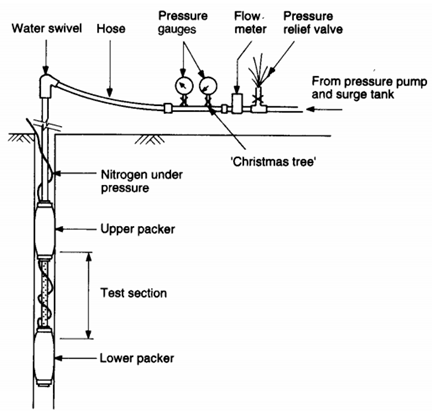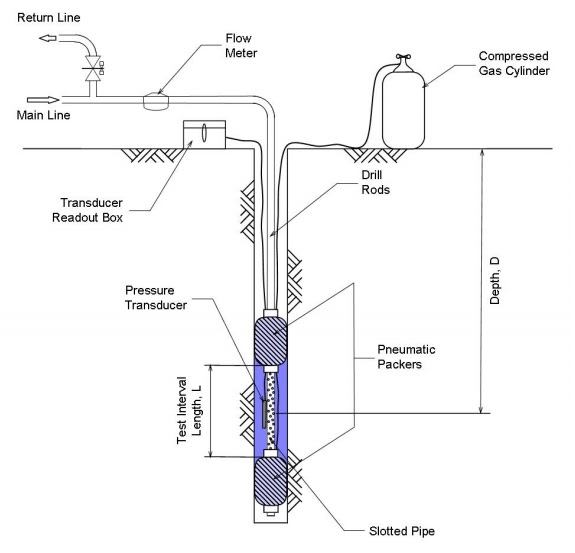Concept
The Lugeon test, sometimes call also Packer test, is an in-situ testing method widely used to estimate the avarage hydraulic conductivity of rock mass. It is indeed In situ test of formation permeability performed by measuring the volume of water taken in a section of test hole when the
interval is pressurized at given pressure (10 bars -150 psi). It is used primarily in variably permeable formations under evaluation of fracturating .
The test is named after Maurice Lugeon (1933), a Swiss geologist who first formulated the test. Basically, the Lugeon test is a costant head permeability type test carried out in a isolated part of a borehole. The results provide information about hzdraulic condictivuty of the rock mass including the rock matrix and the discontinuities.
Description and procedure
The test is conducted in a portion of a borehole isolated by pneumatic packers. The water is injected into the isolated portion of the borehole using a slotted pipe which it self is bounded by the inflated packers. The packers can be inflated using a gas compressor on the surafce, and so they can isolate and seal that portion of the borehole. A pressure transducer is also located in that portion to measure the pressure with a help of reading station on the surface.
First of all, a maximum test pressure (Pmax) is defined so that it does not exceed the in-situ minimum stress, thus avoiding hzdraulic fracturing. The test is carried out at five stages including increasing and decreasing pressure between zero and maximum pressure. At each stage, a constant pressure is applied for an interval of 10 miniutes while pumping water. Water pressure and flow rate are measured everz minute. The five loading and unloading stages form a pressure loop often with the following pressure intervals:
| Stage | Pressure |
| 1st | 0.50 Pmax |
| 2nd | 0.75 Pmax |
| 3rd | Pmax |
| 4th | 0.75 Pmax |
| 5th | 0.50 Pmax |
Using the average values of water presure and flow rate measured at each stage, the average hydraulic conductivity of the rock mass can be determined. Following the empiricl original definition of the test, the hzdraulic conductiviy is experessed in terms of Lugeon Unit, being the conductivity required for a flow aret of 1 liter per minute per meter of the borehole interval under a constant pressure of 1 MPa. The Lugeon value for each test is therefore calculated as follows and then an average representative value is selected for the tested rock mass.
Lugeon Value = (q / L) x (P0 / P)
where
q - flow rate [lit/min]
L - Length of the borehole test interval [m]
P0 - reference pressure of 1 MPa [MPa]
P - Test pressure [MPa]
Considering a homogenous and isotropic condition, one Lugeon will be equal to 1.3e-7m/s. Contrary to the continuum media, the hzdraulic conductivity of the rock mass is very much influenced by the rock discontinuities. Therefore, the Lugeon value could represent not only the conductivity but also the rock jointing condition. Typical range of Lugeon values and the corresponding rock condition is indicated in th etable below [1]
|
Lugeon Value |
Conductivity classification |
Rock discontinuity condition |
|
<1 |
Very low | Very tight |
| 1-5 | Low | Tight |
| 5-15 | Moderate | Few partly open |
| 15-50 | Medium | Some open |
| 50-100 | High | Many open |
| >100 | Very high | Open closely spaced or voids |
Standards
- French Standard NF P 94-131 (1994) Essais d'eau Lugeon
References - External Links
- Withers, Nick J., Leo HJ Schaap, and Clive P. Dalton. "The development of a full displacement pressuremeter." Proc. of the 2nd International Symposium on the Pressuremeter and its Marine Applications, College Station, Texas, ASTM Special technical publication, STP. Vol. 950. 1986
- Houlsby, G.T. and Withers, N.J.,1988, Analysis of the Cone Pressuremeter Test in Clay, Géotechnique, Vol. 38, No. 4, December, pp 575-587, ISSN 0016-8505, Awarded the inaugural Geotechnical Research Medal, Institution of Civil Engineers


